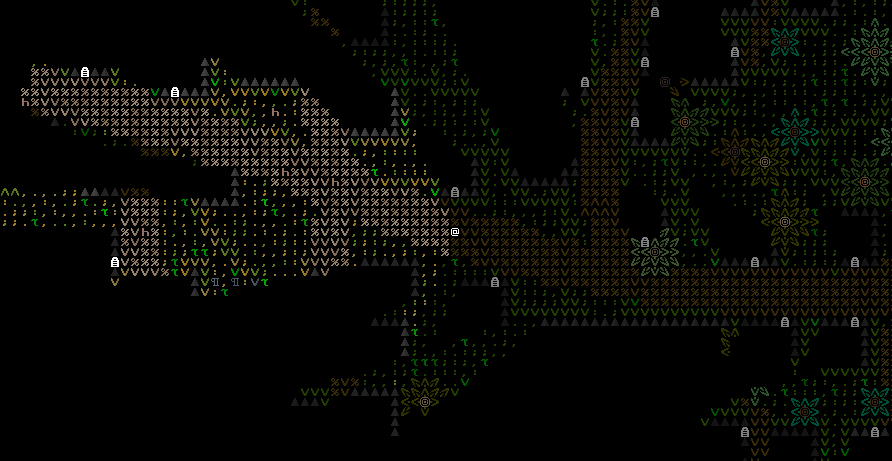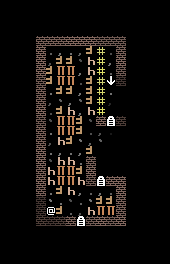Well, it has been another very busy week – I gave a talk on URR’s PCG and AI systems at nucl.ai in Vienna (and spent an afternoon sitting the sun outside a rather nice vegan cafe working on the secret project I’ve mentioned a few times, which continues to inch closer to the point where I can actually announce something) and I’ve also had a piece the 35th Anniversary of Rogue published in Paste Magazine (which you can read here) and another on the role of text and characters in classic roguelikes published in Imaginary Realities (here), but nevertheless significant progress has been made (though I anticipate this next week to be a full week of coding with nothing else, so we should have a major update in seven days).
Towns, Fortresses, Etc
NPCs can now pathfind sensibly around other places which aren’t city districts – they know where to spawn and how to behave in the crowd in fortresses, in towns, in slums, and also in hunter-gatherer encampments. In these cases they generally don’t use the roads, because having people pathfind on a road until they get close to their target, and then move off the road, magnifies pathfinding complexity immensely – what if they get near the target, but then the actual path from the end of the road to the target is long due to a wall (so they are physically proximate but the path to that proximate location is huge), and the complexity of the problem of making sure they take an efficient road path, followed by an efficient off-road path, is massive – so we’re ignoring it. Besides, particularly in towns I think this actually works quite effectively when roads look more like a form of aesthetic/spatial structuring of the town rather than literally what everyone uses to walk around, and fortresses tend not to have roads anyway unless there’s a river cutting through them. The right groups of NPCs now spawn in fortesses and elsewhere, of course, so we see lots of soldiers in fortresses, the poorest of the poor in slums, ordinary citizens in towns, and tribal peoples in hunter-gatherer territories. This is, however, making it clear that I need to return to clothing generation at some point soon and really get moving on the other algorithms for lower/middle class feudal clothing, and other clothing types too – it’s a huge job, and actually bigger than I thought, so I’m going to devote a solid week or two to that once I’m back from GDC Europe (if you’re there, come along to my talk!). Here’s a town brimming with activity:

Inside/Outside
The big one – NPCs now actually go inside buildings (they previously despawned at the door, in essence) and if you then go into the building, you can then see that same NPC inside the building. If the building has already been spawned and exists, then the NPC will go about their business inside the building. Alternatively, if the building hasn’t yet been spawned, they are temporarily placed in “limbo” until one of two things happens. If the building is spawned (i.e. by the player stepping inside), then that NPC is granted a number of turns to move around in the building as if they had been moving around inside the whole time. Alternatively, if an NPC has “entered” a building that the player doesn’t spawn, then after a random length of time they will the leave the building and continue on their way. In this method we are left with no pointless NPCs milling around in “limbo”, ensures that the crowd is always centered on the player, and means that if you see NPCs going into a building, they will be inside. In this gif, an NPC has previously entered this tavern; we’ll now enter, causing the building to spawn, and then the NPC spawns and we see them take a seat, and then if we go outside, they’ll exit again after a certain point (at the end we then see another NPC enter). This basically means that regardless of the player’s actions and which parts of the map actually exist, the crowd’s actions always appear to make sense. A similar system will be needed once I start tracking the important and non-spawned NPCs around the world (rulers, merchants, etc).

Inside Behaviour
NPCs will now create a list of potential “targets” within a building and will hang around at those targets for sensible amounts of time, and then when those timers end, they’ll either leave or go to something else within the building. This process depends on the building and the nature of a given target. For example, someone who goes into a tavern and sits on a chair to drink for a while will not then get up and move to another chair – they’ll either just stay on the chair, or get up and leave. By contrast, somebody in a cathedral might spend a lot of time sitting at one chair worshipping in front of an altar, then move to study the holy texts at a desk, then talk to a priest, then leave, etc. I’m working at the moment on finishing off this list of targets, and then also adding a second layer whereby the list of targets is modulated by the time of day; so people will tend to leave as its gets near night, or people in this houses will head to bed, etc. Here’s a gif of some inside behaviour in a tavern:

As you can see, more people currently leave than enter; I’m working on balancing these two algorithms at the moment so we have a steady flow of entering/leaving whatever structure the player might happen to be in at the time.
Sorry also about the relative lack of images this week: a huge amount of this week’s work has just been improving pathfinding, improving how NPCs move and behave, a lot of technical improvement on saving/loading and managing buildings and floors and buildings which are/aren’t spawned, etc, so there aren’t that many pictures to show. I hope for more next time!
What now?
Making the interior behaviour sensible and interesting for all NPCs, giving buildings a “maximum” number of people they can hold, adding day/night differences, fixing the massive number of edge cases which are slowly building up… etc. More next week!
